Dell U2311H: E-IPS, Full Adjustments, and DisplayPort
by Chris Heinonen on September 27, 2011 12:20 AM ESTBrightness and Contrast
When pushed to its maximum brightness level with maximum contrast, the Dell U2311H can manage to put out over 300 cd/m2 of light from a pure white screen. This is far brighter than most of us would like (other than perhaps Brian), and it does result in very washed out highlights, mostly related to the contrast level. This isn’t a level you would work at often, but if you needed to because of direct sunlight, the Dell could manage that. When keeping the contrast a maximum but reducing the brightness down to 0, the light output drops down to just over 100 cd/m2 whichis much easier on the eyes.
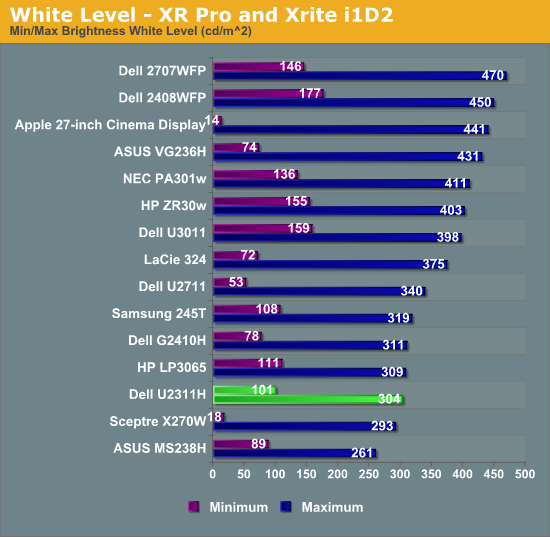
At these same brightness and contrast levels, the light output of an all black screen is 0.303 nits with max brightness, and 0.098 with minimum brightness. I should note that these measurements were taken with an Xrite i1DisplayPro meter instead of the i1Display2, as it does much better reading lower levels of light output. Unfortunately ColorEyesPro does not support this meter at this point and so I couldn’t use it for the whole calibration.
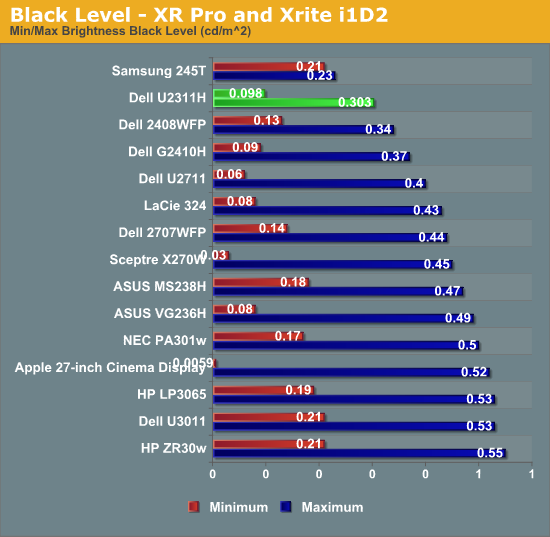
Looking at the On/Off contrast ratio that this creates, we see that both of these produce right around 1,000:1, so you can choose your preferred light output and you will likely get a contrast ratio right around the same level.
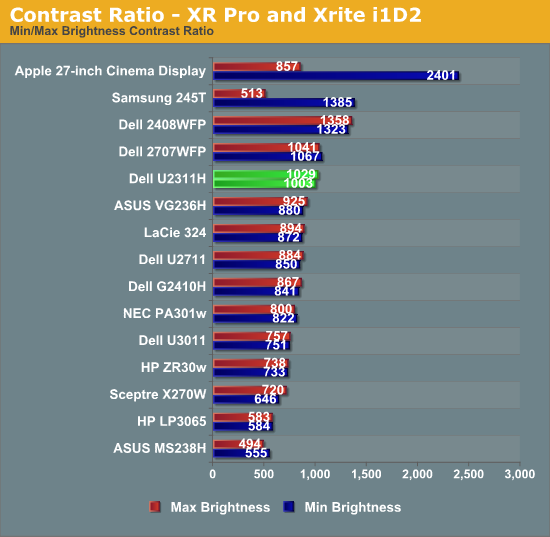
Brightness Uniformity
With 200 nits of light output in the middle of the screen for a white image, the light output drops as low as 161 nits on the left edge of the screen, while staying close to 200 nits on the right side of the display. I’m not sure if it is the layout of the backlights or something else causing this, but the light output is clearly less on the left side of the panel.
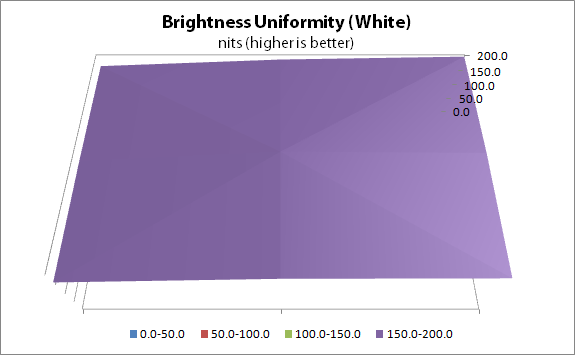
With a black screen, we see the same results. Light output is again higher on the right side of the display and lower at the left, with the upper-right corner being the brightest in both cases.
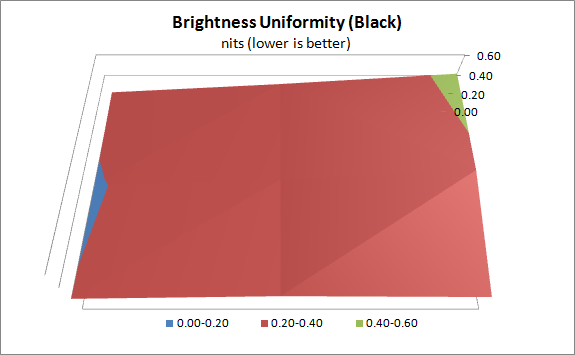










65 Comments
View All Comments
jabber - Tuesday, September 27, 2011 - link
...with just buying a PVA panel instead?Aphelion02 - Tuesday, September 27, 2011 - link
Nice article, but so late as to be dangerously close to being irrelevant. A large amount of people who might have found this useful have already made their purchasing decisions almost a year ago. I have noticed this as quite a trend at AT, with this article and the P8P68 mobo review as being most striking. At some point, the added value of a late review is so minimal you are better off spending the effort on something else.dingetje - Tuesday, September 27, 2011 - link
more 1920x1080 reviews?I like Dell, but here's what I think: they can shove all their 16:9 panels up their @$$
A5 - Tuesday, September 27, 2011 - link
Cool story bro.The market has spoken, and they want cheap 16:9 1080p monitors. Dell isn't going to make a 16:10 monitor that won't sell to satisfy you.
Makaveli - Tuesday, September 27, 2011 - link
Its funny you say that cause Dell already has a 16:10 24' model that is superior to this.The market is also full of dumb ass best buy shoppers!
Dug - Tuesday, September 27, 2011 - link
The market hasn't spoken,No one I have ever spoken too prefers 16:9 to 16:10
And that sentiment is echoed in every forum I come across.
16:9 is what has been shoved down our throats
user1003 - Tuesday, September 27, 2011 - link
This monitor is horrible. The whole stand is nice and adjustable, but the panel itself is plagued with a lot of problems, among them:- tinting (google it, it's a problem with the whole series, and the 24" series too). there are yellow stripes at the screen borders and the whole left side is slightly tinted yellow, too. the area effected by the tinting differs, but a lot of the U23 and U24 Dells have this problem
- the anti glare coating distorts small details like fonts
- the PSU makes a loud humming noise when set to <95% brightness, so you either become blind or deaf
- clouding at the edges
Some of them are better than others so you could get lucky (and let's face it, they sent Anandtech a good one for testing), but overall this monitor just sucks, even considering the low price.
jecs - Tuesday, September 27, 2011 - link
That is too bad. But also makes me feel safe with the higher quality 2470 ultrasharp. This screen is working very well, I have a lot of input connectors to choose from, 1920 x 1200 screen and I have 0 problems after a year of use. But, also remember this new matrices may still be 6 bits for color depth and that LED panels are good on power consumption but not very good for precision color. However I don't know why Dell is having such a product on the market if it not ready. It also makes me wonder if Dell is lowering the quality to appeal to new audiences but instead is disappointing loyal customers.tech6 - Tuesday, September 27, 2011 - link
To all those who complain that this panel is far from perfect for design work: I would have to agree but that's not the market it aims for. For starters, any 1080 panel is no good for layout work so if that's what you're looking for there are a number of $500+ monitors that will meet your needs. This panel is designed as an upgrade to mediocre $200 TN monitors and it does a great job and it does a great job. We bought a number of these for the office last year and they put all other TN panels to shame. For those considering a 1080 work or home display, this is a high quality bargain.Miggleness - Tuesday, September 27, 2011 - link
I've had this monitor for over a year now, hope you can do a followup and put the U2312 to the test as well. You'd definitely be able to get a good assessment on it's improvements over the U2311 (if any) while this review is fresh.